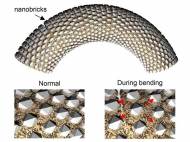New flexible mineral inspired by deep-sea sponges
 Inspired by structural elements found in most sea sponges, researchers at Johannes Gutenberg University Mainz (JGU) and the Max Planck Institute for Polymer Research (MPI-P) in Germany have recreated the sponge spicules using the natural mineral calcium carbonate and a protein of the sponge. The resulting material is a synthetic hybrid which has almost 90 percent of mineral content, yet it is extremely flexible.
Inspired by structural elements found in most sea sponges, researchers at Johannes Gutenberg University Mainz (JGU) and the Max Planck Institute for Polymer Research (MPI-P) in Germany have recreated the sponge spicules using the natural mineral calcium carbonate and a protein of the sponge. The resulting material is a synthetic hybrid which has almost 90 percent of mineral content, yet it is extremely flexible.
Spicules are structural elements found in most sea sponges, and they provide structural support and protection from predators. Unlike natural minerals, which are usually very hard but bristle, spicules are very hard, prickly, and even quite difficult to cut with a knife. They are lightweight, tough, and nearly impenetrable defense system that may serve as inspiration for various new materials.
Inspired by these properties, researchers led by Wolfgang Tremel, Professor at JGU, and Hans-Jürgen Butt, Director at MPI-P, used these natural sponge spicules as a model to cultivate them in the lab. The synthetic spicules were made from calcite (CaCO3) and silicatein-α. The latter is a protein from siliceous sponges that, in nature, catalyzes the formation of silica, which forms the natural silica spicules of sponges.
Silicatein-α was used in the lab setting to control the self-organization of the calcite spicules. The synthetic material was self-assembled from an amorphous calcium carbonate intermediate and silicatein and subsequently aged to the final crystalline material. After six months, the synthetic spicules consisted of calcite nanocrystals aligned in a brick wall fashion with the protein embedded like cement in the boundaries between the calcite nanocrystals. The spicules were of 10-300 micrometers in length with a diameter of 5-10 micrometers.
Synthetic spicules created by JGU and MPI-P researchers are superior to their natural counterparts in terms of flexibility. Exhibiting a rubber-like flexibility, the synthetic spicules can easily be bent into U-shape without breaking or showing any signs of fracture.
This highly unusual characteristic is mainly due to the part of organic substances in the new hybrid material. It is about ten times bendier than their natural counterparts. JGU researchers claim they have found that the synthetic spicules have another special characteristic, because they are able to transmit light waves even when they are bent.
For more information, read the paper published in journal Science: “Flexible Minerals: Self-Assembled Calcite Spicules with Extreme Bending Strength”.










Leave your response!